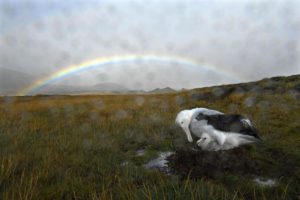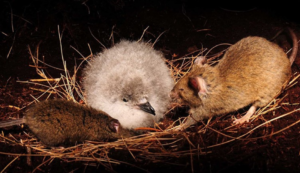MONDAY, 18 MAY 2020
When researchers at Marion Island began investigating why albatross populations were declining, they discovered something no one could have imagined. Dozens of birds had been scalped with raw wounds all around their crowns and necks. They were being eaten alive by – that’s right – mice. The inconspicuous house mouse had developed a taste for blood. A wandering albatross shelters its chick from rain on Marion Island. Photograph by Thomas P. Peschak, National Geographic.
A wandering albatross shelters its chick from rain on Marion Island. Photograph by Thomas P. Peschak, National Geographic.With no natural predators of their own on this remote oceanic island, the mice have sought out these seabirds to nibble away at their flesh throughout the night. Part of the problem is rooted in global climate change, which has allowed more mice to survive through warmer winters, resulting in greater depletion of the mice’s usual prey, such as moths, weevils, and seeds. Unfortunately, the albatrosses lack an instinctual fear of Dracula’s best friends and do not retaliate against the mice. While attacks were initially targeted at the rump and wings, the thinner feather lining on the head means that scalping is now the preferred mode of attack by mice across the island.

A seabird chick making unwanted rodent friends. Photograph by Peter Ryan, Royal Society for the Protection of Birds.
Thankfully, BirdLife South Africa and the South African government have swooped to the rescue, having implemented a program to drop poisoned grain as bait in an effort to clear the entire island of mice by the end of 2021. The mission is not a simple one – pilots will need to navigate extreme weather and brutal wind conditions to drop the bait on every square meter of the island, with an area spanning over eight times that of Cambridge. From there, it will take two years before researchers can assess whether the program worked and the mice have stopped giving non-consensual scalp massages. Until then, all there is to do is wait.
References:
- Caravaggi, A., Cuthbert, R., Ryan, P., Cooper, J., & Bond, A. (2018). The impacts of introduced House Mice on the breeding success of nesting seabirds on Gough Island. Ibis, 161(3), 648-661. doi: 10.1111/ibi.12664
- Davis, J. (2018). Gangs of mice are eating seabird chicks alive on a remote Atlantic island. Accessed 9 March 2020.
- Dilley, B., Schoombie, S., Schoombie, J., & Ryan, P. (2015). ‘Scalping’ of albatross fledglings by introduced mice spreads rapidly at Marion Island. Antarctic Science, 28(2), 73-80. doi: 10.1017/s0954102015000486
- Jones, C., Risi, M., Cleeland, J., & Ryan, P. (2019). First evidence of mouse attacks on adult albatrosses and petrels breeding on sub-Antarctic Marion and Gough Islands. Polar Biology, 42(3), 619-623. doi: 10.1007/s00300-018-02444-6
- Jones, M., & Ryan, P. (2009). Evidence of mouse attacks on albatross chicks on sub-Antarctic Marion Island. Antarctic Science, 22(01), 39. doi: 10.1017/s0954102009990459 Nemo, L. (2018). Saving a remote island’s birds—by getting rid of its mice. Accessed 9 March 2020.
Anna Tran is a BlueSci contributor.
